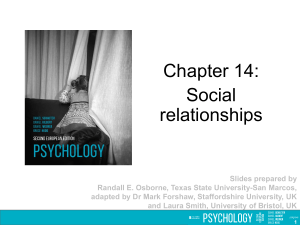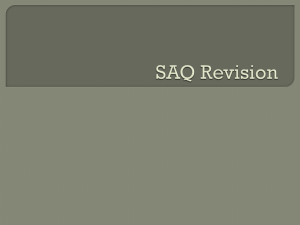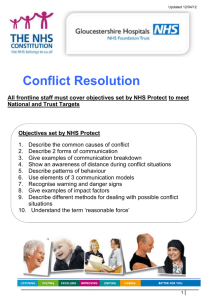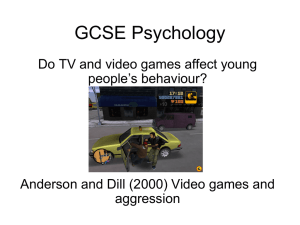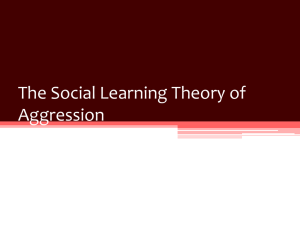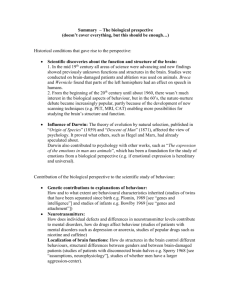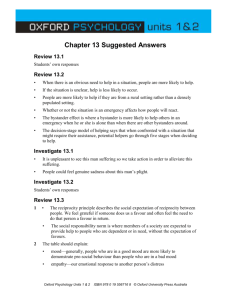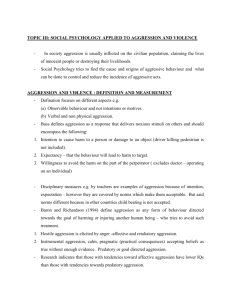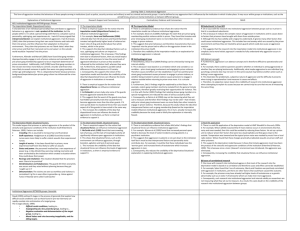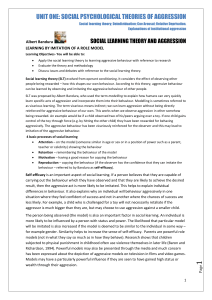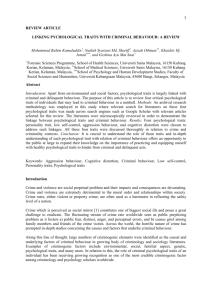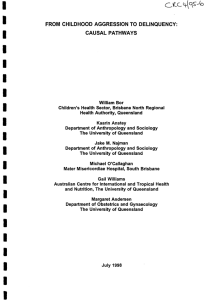Explanations of institutional aggression.doc
advertisement
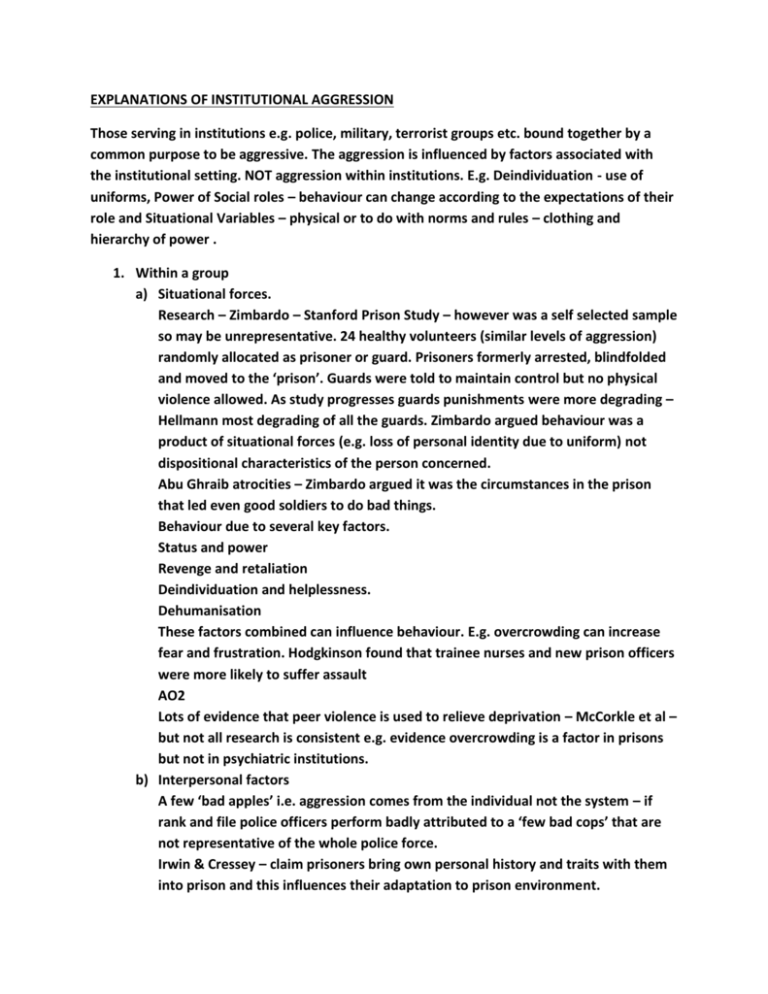
EXPLANATIONS OF INSTITUTIONAL AGGRESSION Those serving in institutions e.g. police, military, terrorist groups etc. bound together by a common purpose to be aggressive. The aggression is influenced by factors associated with the institutional setting. NOT aggression within institutions. E.g. Deindividuation - use of uniforms, Power of Social roles – behaviour can change according to the expectations of their role and Situational Variables – physical or to do with norms and rules – clothing and hierarchy of power . 1. Within a group a) Situational forces. Research – Zimbardo – Stanford Prison Study – however was a self selected sample so may be unrepresentative. 24 healthy volunteers (similar levels of aggression) randomly allocated as prisoner or guard. Prisoners formerly arrested, blindfolded and moved to the ‘prison’. Guards were told to maintain control but no physical violence allowed. As study progresses guards punishments were more degrading – Hellmann most degrading of all the guards. Zimbardo argued behaviour was a product of situational forces (e.g. loss of personal identity due to uniform) not dispositional characteristics of the person concerned. Abu Ghraib atrocities – Zimbardo argued it was the circumstances in the prison that led even good soldiers to do bad things. Behaviour due to several key factors. Status and power Revenge and retaliation Deindividuation and helplessness. Dehumanisation These factors combined can influence behaviour. E.g. overcrowding can increase fear and frustration. Hodgkinson found that trainee nurses and new prison officers were more likely to suffer assault AO2 Lots of evidence that peer violence is used to relieve deprivation – McCorkle et al – but not all research is consistent e.g. evidence overcrowding is a factor in prisons but not in psychiatric institutions. b) Interpersonal factors A few ‘bad apples’ i.e. aggression comes from the individual not the system – if rank and file police officers perform badly attributed to a ‘few bad cops’ that are not representative of the whole police force. Irwin & Cressey – claim prisoners bring own personal history and traits with them into prison and this influences their adaptation to prison environment. AO2 Some support for I&C e.g. factors such as age, education level and race do seem to effect aggression. Black inmates have higher rates of violent behaviour but lower alcohol and drug related misconduct. c) Hazing – a form of institutional bullying. Based on a tradition in many groups to discipline junior members and maintain a strict pecking order. Initiations can spiral out of control and cause lasting physical and psychological damage. (student clubs) AO2 Research evidence supporting the concept e.g. McCorkle found in prisons, domination of weak seen as essential. But what constitutes aggressive behaviour – many exposed to hazing see it as harmless fun. AO2 Research into aggression is difficult. Information is socially sensitive and control of variables very difficult, so cannot establish cause and effect. There is only a limited amount of well documented studies. Bernard – aggression is seen as ‘just’, ’acceptable’ and in some situations ‘expected’ because the working environment of most police officers is mainly structured by codes of deviance, secrecy, silence and cynicism. i.e. the situation that leads to show of aggression. Robert Agnew – General Strain Theory. Negative experiences and stress generate negative effective states (feelings and emotions) and without effective coping strategies can lead to violent behaviour. Strain emerges from negative relationships with others – when individual feels they have not been treated in manner they think is appropriate. Can lead to anger and frustration. 2. Between groups – AO1 E.g. Genocide. The murder of 6 million Jews by the Nazis and murder of 800 000 Tutsi and moderate Hutu by extremist Hutu (Rwanda). Staub outlined 5 stages in the process of genocide. Difficult social conditions Scapegoating of less powerful group Negative evaluation and dehumanisation of target group Moral values and rules no longer apply and killing starts Passivity of bystanders enhances the process E.G of dehumanising – Hutu controlled ‘hate’ radio referred to the Tutsi as cockroaches. Obedience to authority – Milgram believed the holocaust mainly due to situational pressures that forced the Nazi soldier to obey their leaders, regardless of any personal repugnance. AO2 Staub’s model emphasises the importance of bystander behaviour in preventing genocide. (doing nothing may actually escalate killings by signalling apathy) Intervention can effect duration and severity – in different ways . Intervention by e.g. the UN may shorten the conflict it might also increase the severity – in Rwanda 800 000 died in just 100 days. Evidence of dehumanisation – can also explain violence against immigrants. Social dominance orientation (SDO). People high in SDO endorse social hierarchies and see world as ‘competitive jungle’. Esses – showed individuals high in SDO tend to dehumanise outgroup, especially refugees and asylum seekers. Negative attitudes are rationalised through ‘legitimising myths’ e.g. foreign refugees are by nature deviant and therefore deserve our hostility. Mandel rejects Migram’s claims – argues Milgram’s account is monocausal and doesn’t match historical record. Goldhanger suggests main cause was anti –Semitism. Dehumanisation is difficult to investigate empirically- difficult to define what is and what isn’t dehumanising behaviour. Ethical issues in studying people who have been subjected to dehumanising violence.
